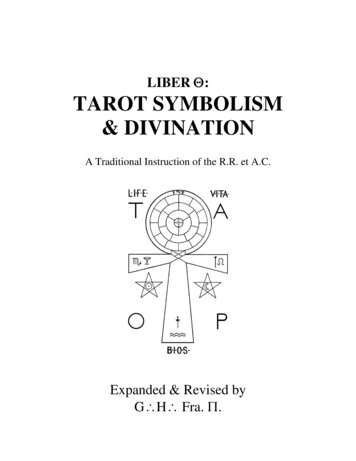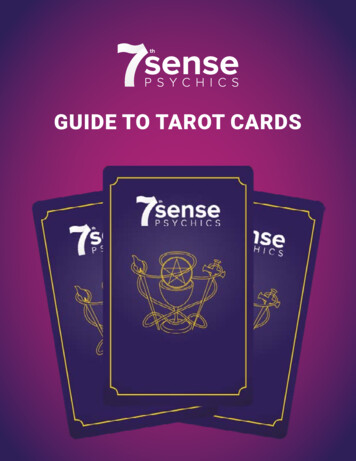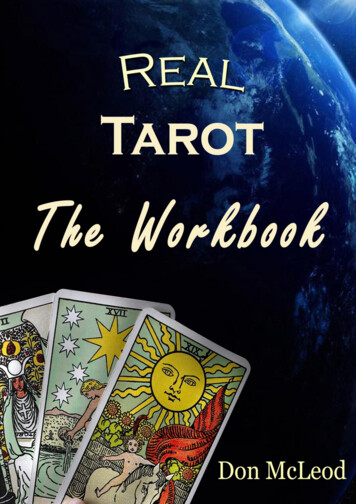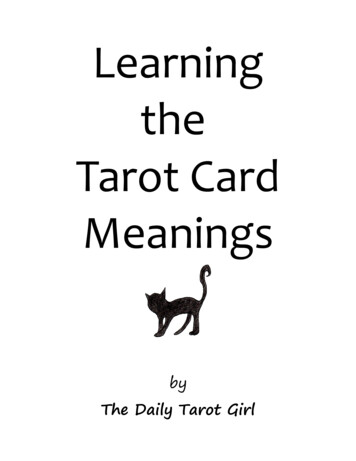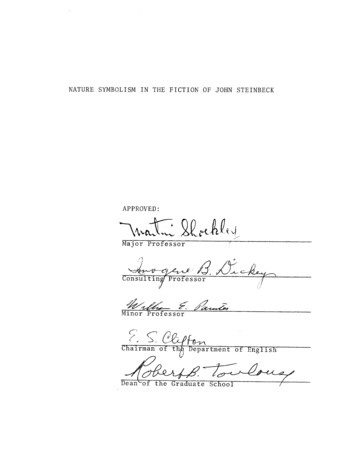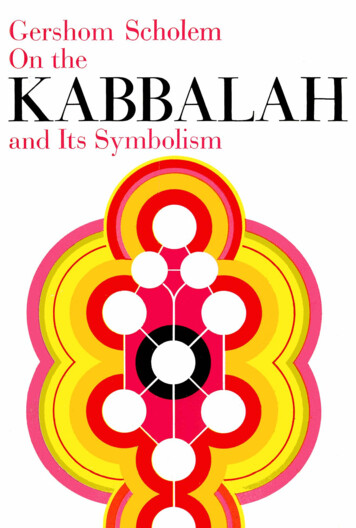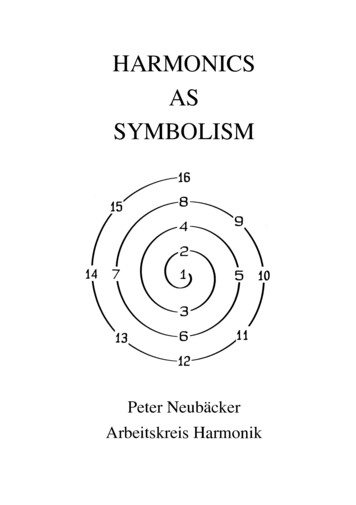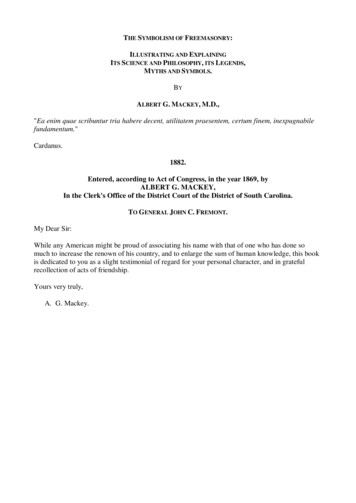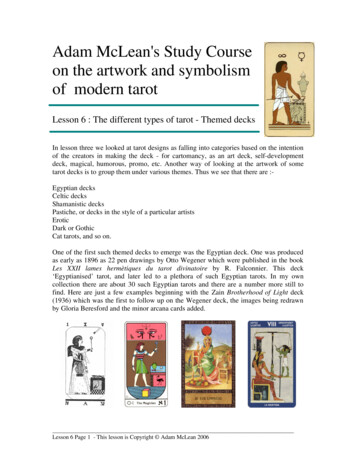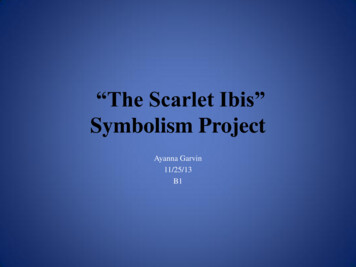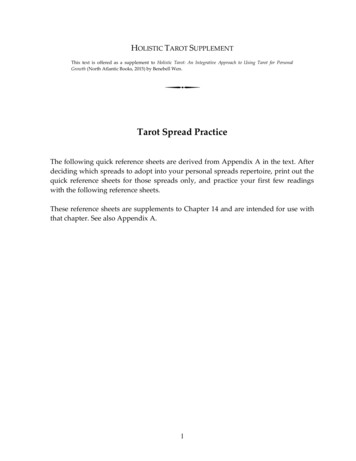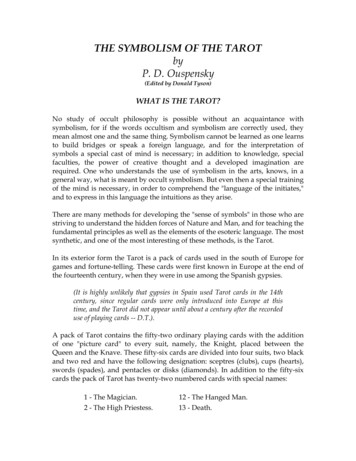
Transcription
THE SYMBOLISM OF THE TAROTbyP. D. Ouspensky(Edited by Donald Tyson)WHAT IS THE TAROT?No study of occult philosophy is possible without an acquaintance withsymbolism, for if the words occultism and symbolism are correctly used, theymean almost one and the same thing. Symbolism cannot be learned as one learnsto build bridges or speak a foreign language, and for the interpretation ofsymbols a special cast of mind is necessary; in addition to knowledge, specialfaculties, the power of creative thought and a developed imagination arerequired. One who understands the use of symbolism in the arts, knows, in ageneral way, what is meant by occult symbolism. But even then a special trainingof the mind is necessary, in order to comprehend the "language of the initiates,"and to express in this language the intuitions as they arise.There are many methods for developing the "sense of symbols" in those who arestriving to understand the hidden forces of Nature and Man, and for teaching thefundamental principles as well as the elements of the esoteric language. The mostsynthetic, and one of the most interesting of these methods, is the Tarot.In its exterior form the Tarot is a pack of cards used in the south of Europe forgames and fortune-telling. These cards were first known in Europe at the end ofthe fourteenth century, when they were in use among the Spanish gypsies.(It is highly unlikely that gypsies in Spain used Tarot cards in the 14thcentury, since regular cards were only introduced into Europe at thistime, and the Tarot did not appear until about a century after the recordeduse of playing cards -- D.T.).A pack of Tarot contains the fifty-two ordinary playing cards with the additionof one "picture card" to every suit, namely, the Knight, placed between theQueen and the Knave. These fifty-six cards are divided into four suits, two blackand two red and have the following designation: sceptres (clubs), cups (hearts),swords (spades), and pentacles or disks (diamonds). In addition to the fifty-sixcards the pack of Tarot has twenty-two numbered cards with special names:1 - The Magician.2 - The High Priestess.12 - The Hanged Man.13 - Death.
3 - The Empress.4 - The Emperor.5 - The Chariot. (7).6 - The Lovers.7 - The Hierophant. (5).8 - Strength.9 - The Hermit.10 - The Wheel of Fortune.11 - Justice.14 - Temperance.15 - The Devil.16 - The Tower.17 - The Star.18 - The Moon.19 - The Sun.20 - Judgment.21 - The World.0 - The Fool.(It is odd that Ouspensky offers no explanation or justification for hisinversion of the places of the trumps VII: The Chariot and V: TheHierophant. The inversion of these cards is not common amongoccultists. It is not supported by any major authority of whom I am aware.-- D.T.)This pack of cards, in the opinion of many investigators, represents the Egyptianhieroglyphic book of seventy-eight tablets, which came to us almostmiraculously.(The fanciful notion that the Tarot is Egyptian in origin comes from thespeculations of the French writer Court de Gébelin, who in 1781 publishedthe eighth volume of his nine volume work Le Monde Primitif Analyséet Comparé avec le Monde Moderne, in which he put forth thesuggestion that the Tarot had originated in Egypt and had been carriedinto Europe by gypsies. This concept was embraced by such Frenchoccultists as Etteilla, Levi and Paul Christian, even though it is withoutbasis. -- D.T.)The history of the Tarot is a great puzzle. During the Middle Ages, when it firstappeared historically, there existed a tendency to build up synthetic symbolicalor logical systems of the same sort as Ars Magna by Raymond Lully. Butproductions similar to the Tarot exist in India and China, so that we cannotpossibly think it one of those systems created during the Middle Ages in Europe;it is also evidently connected with the Ancient Mysteries and the EgyptianInitiations. Although its origin is in oblivion and the aim of its author or authorsquite unknown, there is no doubt whatever that it is the most complete code ofHermetic symbolism we possess.(Something similar to ordinary playing cards existed in China and Indiaprior to the appearance of playing cards in Europe; however, the Tarot
trumps did not appear in Eastern countries before they were known inEurope, and were probably invented in Italy in the 15th century. Thesymbolism of the trumps is completely European, apart from a few fauxPersian trappings. The most likely explanation is that playing cards madetheir way into Europe via the Crusades, and that a century or so later, theTarot trumps were developed in Italy, perhaps as a symbolic mnemonicdevice, and combined with the ordinary gambling deck, which in one of itsforms must have possessed four royal cards in each suit rather than three.-- D.T.)Although represented as a pack of cards, the Tarot really is something quitedifferent. It can be "read" in a variety of ways. As one instance, I shall give ametaphysical interpretation of the general meaning or of the general content ofthe book of Tarot, that is to say, its metaphysical title, which will plainly showthat this work could not have been invented by illiterate gypsies of thefourteenth century.The Tarot falls into three divisions: The first part has twenty-one numberedcards; the second part has one card 0; the third part has fifty-six cards, i.e., thefour suits of fourteen cards. Moreover, the second part appears to be a linkbetween the first and third parts, since all the fifty-six cards of the third parttogether are equal to the card 0.(It is more usual to divide the Tarot into two parts, the 56 suit cards andthe 22 trumps or picture cards. Ouspensky's assertion that the Fool issomehow equal to the Lesser Arcana or suit cards is his own insight, andis not widely supported in the literature of the Tarot. In the traditionalTarot the Fool is unnumbered, but it was the practice of the Frenchoccultists of the 19th century to sometimes assign the Fool a numericalvalue of zero. This practice was later adopted by the Golden Dawn. -D.T.)Now, if we imagine twenty-one cards disposed in the shape of a triangle, sevencards on each side, a point in the centre of the triangle represented by the zerocard, and a square round the triangle (the square consisting of fifty-six cards,fourteen on each side), we shall have a representation of the relation betweenGod, Man and the Universe, or the relation between the world of ideas, theconsciousness of man and the physical world.
The triangle is God (the Trinity) or the world of ideas, or the noumenal world.The point is man's soul. The square is the visible, physical or phenomenal world.Potentially, the point is equal to the square, which means that all the visibleworld is contained in man's consciousness, is created in man's soul. And the soulitself is a point having no dimension in the world of the spirit, symbolized by thetriangle. It is clear that such an idea could not have originated with ignorantpeople and clear also that the Tarot is something more than a pack of playing orfortune-telling cards.H. P. Blavatsky mentions the Tarot in her works, and we have some reason forbelieving that she studied the Tarot. It is known that she loved to "play patience."We do not know what she read in the cards as she played this game, but theauthor was told that Madame Blavatsky searched persistently and for a long timefor a MSS. on the Tarot.(Blavatsky writes very little concerning the Tarot. The game of patience orsolitaire is played with an ordinary deck of 52 cards and has nothing to dowith the Tarot. Ordinary cards were often used to divine the future, butagain, the methods of divination used with a common gambling deck arenot similar to the methods of Tarot divination. – D.T.)In order to become acquainted with the Tarot, it is necessary to understand thebasic ideas of the Kabala and of Alchemy. For it represents, as, indeed, manycommentators of the Tarot think, a summary of the Hermetic Sciences -- theKabala, Alchemy, Astrology, Magic, with their different divisions. All thesesciences, attributed to Hermes Trismegistus, really represent one system of avery broad and deep psychological investigation of the nature of man in hisrelation to the world of noumena (God, the world of Spirit) and to the world ofphenomena (the visible, physical world). The letters of the Hebrew alphabet andthe various allegories of the Kabala, the names of metals, acids and salts inalchemy; of planets and constellations in astrology; of good and evil spirits inmagic -- all these were only means to veil truth from the uninitiated.
(Neither the Kabbalah nor astrology have any strong connection withHermes Trismegistus. This semi-divine figure is linked with alchemy andmagic in ancient writings. Of course, magic uses astrology, and thenumerological methods of the Kabbalah are somewhat similar in theirgeneral procedures to the numerology of Pythagoras, which can beassociated obliquely with Hermes Trismegistus. -- D.T.)But when the true alchemist spoke of seeking for gold, he spoke of gold in thesoul of man. And he called gold that which in the New Testament is called theKingdom of Heaven, and in Buddhism, Nirvana. And when the true astrologerspoke of constellations and planets he spoke of constellations and planets in thesoul of man, i.e., of the qualities of the human soul and its relations to God and tothe world. And when the true Kabalist spoke of the Name of God, he sought thisName in the soul of man and in Nature, not in dead books, nor in biblical texts,as did the Kabalist-Scholastics. The Kabala, Alchemy, Astrology, Magic areparallel symbolical systems of psychology and metaphysics. Any alchemicalsentence may be read in a Kabalistic or astrological way, but the meaning willalways be psychological and metaphysical.(Many intelligent, serious alchemists of the Middle Ages and theRenaissance devoted all their time to the manufacture of gold from basemetals. They were interested in spiritual perfection only as a means toattain this material purpose. One such was Edward Kelley, the seer of Dr.John Dee. He sought gold the metal, not the gold of the spirit. Also, thekingdom of heaven and nirvana are hardly synonymous -- the first is acondition attained only after death, the second a state of mind attainableduring life. -- D.T.)We are surrounded by a wall built of our conceptions of the world, and areunable to look over this wall at the real world. The Kabala presents an effort tobreak this "enchanted circle." It investigates the world as it is, the world in itself.The world in itself, as the Kabalists hold, consists of four elements, or the fourprinciples forming one. These four principles are represented by the four lettersof the name of Jehovah. The basic idea of the Kabala consists in the study of theName of God in its manifestation. Jehovah in Hebrew is spelt by four letters,Yod, He, Vau and He -- I. H. V. H. To these four letters is given the deepestsymbolical meaning. The first letter expresses the active principle, the beginningor first cause, motion, energy, "I"; the second letter expresses the passive element,inertia, quietude, "not I;" the third, the balance of opposites, "form"; and thefourth, the result or latent energy.
(Strictly speaking, there is no name "Jehovah" -- this name is the result ofan error by 14th century Christian scholars in reading the Hebrewconsonants for IHVH along with the vowel points for Adonai (Lord),which is how IHVH was usually voiced aloud when read by Jews, sincethe correct pronunciation of IHVH was secret and forbidden. -- D.T.)The Kabalists affirm that every phenomenon and every object consists of thesefour principles, i.e., that every object and every phenomenon consists of theName of God (The Word), -- Logos.The study of this Name (or the four-lettered word, tetragrammaton, in Greek)and the finding of it in everything constitutes the main problem of Kabalisticphilosophy.To state it in another way the Kabalists hold that these four principles penetrateand create everything. Therefore, when the man finds these four principles inthings and phenomena of quite different categories (where before he had notseen similarity), he begins to see analogy between these phenomena. And,gradually, he becomes convinced that the whole world is built according to oneand the same law, on one and the same plan. The richness and growth of hisintellect consists in the widening of his faculty for finding analogies. Thereforethe study of the law of the four letters, or the name of Jehovah presents apowerful means for widening consciousness.This idea is perfectly clear, for if the Name of God be really in all (if God bepresent in all), all should be analogous to each other -- the smallest particleanalogous to the whole, the speck of dust analogous to the universe, and allanalogous to God. The Name of God, the Word or Logos is the origin of theworld. Logos also means Reason; the Word is the Logos, the Reason ofeverything.There is a complete correspondence between the Kabala and Alchemy andMagic. In Alchemy the four elements which constitute the real world are calledfire, water, air and earth; these fully correspond in significance with the fourkabalistic letters. In Magic they are expressed as the four classes of spirits: elves(or salamanders), undines, sylphs and gnomes.(Elves are not synonymous with salamanders, the elemental spirits of Fire.Elves are traditionally considered to be household spirits or woodlandspirits. -- D.T.)The Tarot in its turn is quite analogous to the Kabala, Alchemy and Magic, and,as it were, includes them. Corresponding to the four first principles or four
letters of the Name of God, or the four alchemistic elements, or the four classes ofspirits, the Tarot has four suits -- sceptres, cups, swords and pentacles. Thusevery suit, every side of the square, equal to the point, represents one of theelements, controls one class of spirits. The sceptres are fire or elves (orsalamanders); the cups are w
the book of Tarot, that is to say, its metaphysical title, which will plainly show that this work could not have been invented by illiterate gypsies of the fourteenth century. The Tarot falls into three divisions: The first part has twenty-one numbered cards; the second part has one card 0; the third part has fifty-six cards, i.e., the four suits of fourteen cards. Moreover, the second part .
